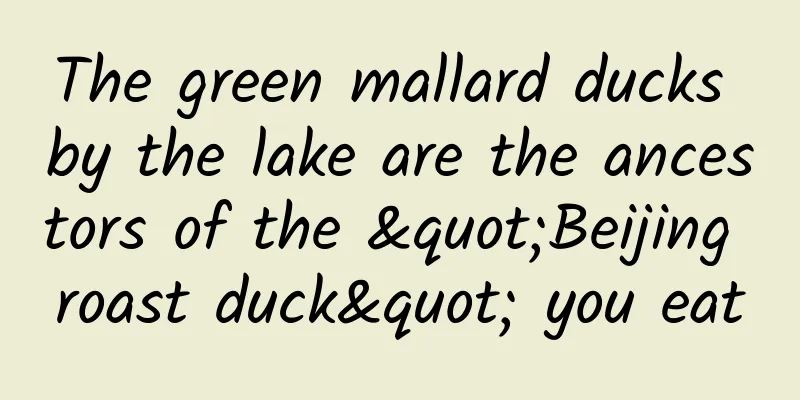The green mallard ducks by the lake are the ancestors of the "Beijing roast duck" you eat

|
In spring, the bird food source area of Beijing Wild Duck Lake Wetland Nature Reserve welcomes a large number of mallards. Local friends in Beijing should be able to see them by the rivers and lakes in city parks recently. Mallard ducks in Beijing. Source: Weibo: @拍鸟的伊诺 In recent years, mallards have become a dominant bird species in Beijing. According to data from the China Bird Watching Record Center, mallards were observed 9,238 times in Beijing in 2022, accounting for more than half of the observed birds. Although it is very common, most people see the mallard as just an ordinary "wild duck". In fact, it has a deep connection with our domestic ducks. For example, the "Peking Roast Duck" you eat contains its descendants. Today let us talk about the story of the mallard. Where do mallard ducks come from? Mallard (Anas platyrhynchos) is a large waterfowl in the family Anatidae of the order Anseriformes. It mainly inhabits shallow lakes and ponds with abundant aquatic plants. It can also be seen in reservoirs, river bays, estuaries, etc. in winter. It is distributed throughout Asia, Europe and North America in the northern hemisphere. Image source: Weibo @Yinuo who takes photos of birds Most of the mallards living in my country are migratory birds, and a few will stay in the local area for the winter. Some subspecies abroad are resident birds. From mid-October to April of the following year, mallards are the main "leaders" of wintering ducks, accounting for about 37% of the total number of wintering ducks in Dongting Lake, Poyang Lake and Taihu Lake in the south, and there are also considerable numbers in the southeast coastal areas. When the weather warms up, they will gather into large groups of hundreds or even thousands of individuals, and then travel long distances northward, relying on rivers, valleys and lakes to find their breeding grounds. Mallard ducks on the move. Image source: wpr.org In early June, ducklings can be seen in Fuyuan, Heilongjiang Province, and female ducks with ducklings can also be seen in Beijing after May. The ancestor of the domestic duck Mallards are large in size, and their taste is top-notch game whether they are steamed, boiled or roasted, so the ancient Chinese started the "domestication plan for mallard ducks" very early on. The earliest written record can be traced back to the Warring States Period (475-221 BC). "Shi Zi" mentioned: "Wild ducks are called fu, and domestic ducks are called herons." In the Northern Wei Dynasty, Jia Sixie's "Qimin Yaoshu" was already teaching people how to keep breeding ducks so that they could hatch ducklings the following year. Li Shizhen of the Ming Dynasty also gave a relatively detailed explanation of the types of ducks, artificial hatching, and growth and development. Image source: Wikipedia After thousands of years of domestic breeding and selection, domestic ducks were gradually cultivated. The "quack" call of ducks we are familiar with now is very similar to the "ga-ga" call of female mallards. However, it is worth mentioning that the "sexual partners" of mallards are not limited to their own population. They can even fall in love with other species. They can mate with many types of ducks, such as spot-billed ducks and red-billed ducks , and thus give birth to many hybrid breeds. Therefore, Chinese scientists have also traced the origin of Chinese ducks through modern scientific and technological means. Experimental paired ducks Source Research Attached Research on partial sequencing of mitochondrial DNA shows that the origin of Chinese ducks, in addition to domesticated wild purebred mallards, also comes from wild hybrid mallards and hybrids of mallards and spot-billed ducks. Nowadays, we can still see transitional domestic wild ducks in southern China. When herding domestic ducks, hunters will crossbreed wild mallards with domestic ducks. The offspring are called "matchmaking ducks". Then, they use the calls of "matchmaking ducks" to lure migrating ducks. This method has appeared in the famous animation "Tom and Jerry". The brighter the duck's bill, the healthier its offspring Mallards also follow the common animal principle of "beautiful males and mediocre females". During the breeding season, the head and upper neck of adult males will be bright emerald green, with a narrow white collar on the lower neck and a conspicuous yellow bill, which is particularly eye-catching in the wild. In contrast, females are much more low-key, with a yellow-brown body, which looks ordinary. Image source: Wikipedia Of course, this is the result of female evolutionary selection. As mothers, they need to take on the responsibilities of hatching offspring and raising children. If they dress up "flashy", they will easily be exposed to the sight of natural enemies. In addition, females do not have "courtship anxiety", they only need to choose good-looking and healthy male ducks. As for the mate selection criteria, females pay great attention to one thing, that is the duck's bill. They prefer males with brightly colored bills because the color is in some way an indicator of a potential mate's health or ability to produce healthy offspring. Studies have shown that the color of a duck's bill affects its sperm production rate and the sperm's antibacterial ability. Image credit: Nicolas Stettler For example, E. coli is common in feces and can harm the quality and vitality of human sperm. For ducks, their cloaca is a combination of the digestive system and reproductive system, so duck sperm needs to be able to resist bacteria. Through experiments, scientists found that the brighter the color of the duck's beak, the better the ability of its sperm to kill E. coli. For most organisms, if sexual intercourse spreads bacteria, it will have a negative impact on both partners. On the one hand, it will reduce the vitality of male sperm and reduce the success rate of conception. On the other hand, it will make females sick and unable to take good care of their offspring after they are born. So no matter what, health always comes first. References: 【1】Zheng Zuoxin et al., 1979. Fauna Sinica, Aves, Volume II, Anseriformes. Beijing: Science Press. 143 pages, 65 figures, 10 plates. Sexual ornamentation reflects antibacterial activity of ejaculates in mallards https://royalsocietypublishing.org/doi/10.1098/rsbl.2011.0276 Chinese Domestic Ducks Evolved from Mallard Duck (Anas platyrhynchos) and Spot-Billed Duck (A. zonorhyncha) https://www.mdpi.com/2076-2615/13/7/1156 Author: Fish Winner of the Silver Award for Outstanding Science Popularization Works of China Science Writers Association For those who love steamed fish head, spicy fish head and other fish head |
<<: These 7 habits you thought were "healthy" might be wrong!
>>: My diet is already very light, so why was I diagnosed with high blood lipids?
Recommend
Why are there such big differences in the prices for WeChat mini program development and mini program development?
It has been 6 years since the mini program was la...
Is artificial intelligence about to "awaken"? Experts give some advice!
In June 2022, a piece of news sparked a heated di...
Don't buy this kind of fertilizer online to grow plants! Some people got seriously ill and almost died because of it
They accidentally came into contact with the fece...
The location of Wenchang Tower before the exam
Many parents are very concerned about their child...
The latest guide to advertising after consumption upgrade!
When placing advertisements, many advertisers pre...
If you are given 10 million for promotion, how can you effectively distribute the channels?
To be honest, in today's fierce market enviro...
How to promote an H5 that cost 20,000 yuan?
Weibo, WeChat, H5, offline activities ... If you a...
Eight "traps" to avoid in the programmer profession
[[229123]] Let's face it. Some of you got int...
2 long product guide pictures completed in 3 days. Why are people so keen on guides?
I graduated from university with a major in e-com...
Will the epidemic affect human psychology for 20 years? Experts say so...
Working from home, online teaching, and staying a...
What was the appearance of the universe like 13.8 billion years ago? The most distant "baby galaxy" tells you the answer →
The existence of JADES-GS-z14-0 is like an "...
How to use gas safely? The "four diagnostic methods" of observation, smell, questioning and palpation are useful! Save it now
Review expert: Luo Huachun, editor-in-chief of &q...
Meizu's layoffs spark a major reshuffle? LeEco, Lenovo, and TCL's mobile phone businesses are also in trouble
There is a good news or a bad news. Which one do ...
AI Market Report
Marketing and sales departments are taking AI and...
Chen Kai stock intraday T+0 trading system
Chen Kai stock intraday T+0 trading system resour...









